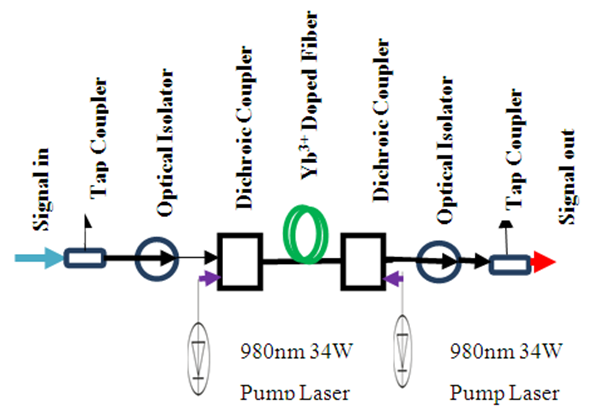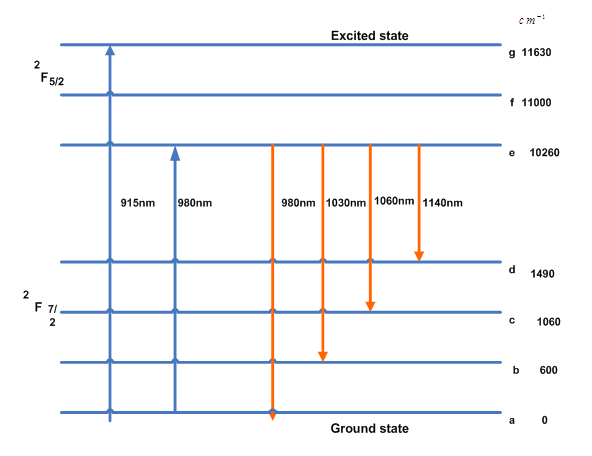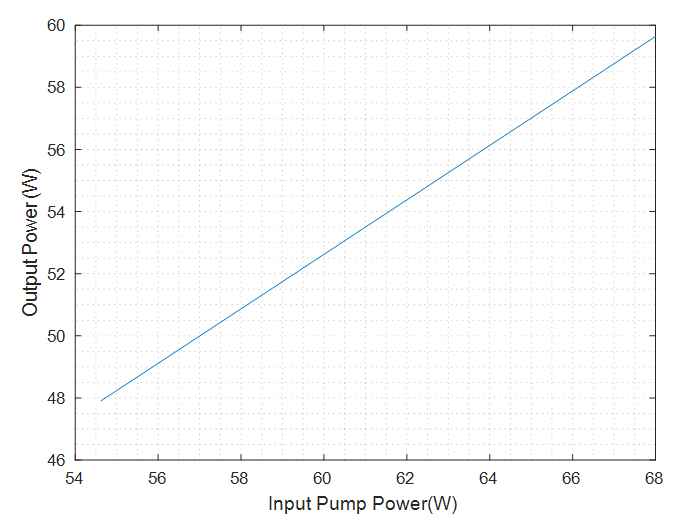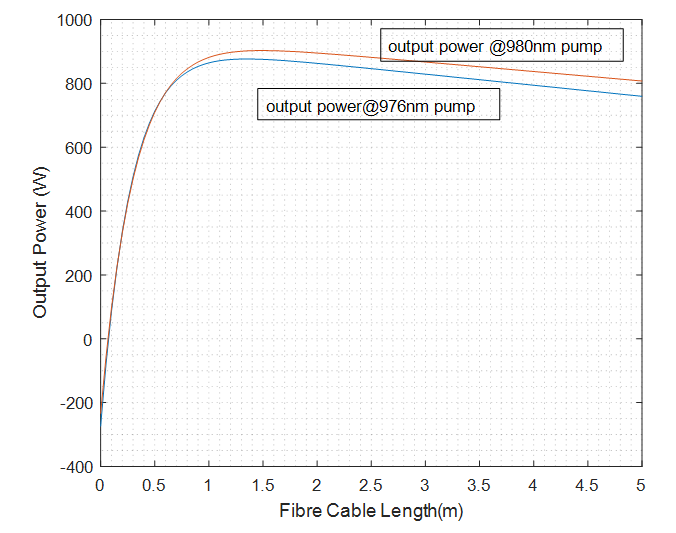-
Paper Information
- Paper Submission
-
Journal Information
- About This Journal
- Editorial Board
- Current Issue
- Archive
- Author Guidelines
- Contact Us
International Journal of Optoelectronic Engineering
p-ISSN: 2167-7301 e-ISSN: 2167-731X
2021; 10(1): 1-8
doi:10.5923/j.ijoe.20211001.01
Received: Dec. 10, 2020; Accepted: Dec. 26, 2020; Published: Jan. 15, 2021

Design of Yb3+ Doped Laser for Industrial Application
Moses Simpungwe, Charles Lubobya, Sampa Nkonde
Department of Electrical and Electronic Engineering, University of Zambia, Lusaka, Zambia
Correspondence to: Moses Simpungwe, Department of Electrical and Electronic Engineering, University of Zambia, Lusaka, Zambia.
| Email: |  |
Copyright © 2021 The Author(s). Published by Scientific & Academic Publishing.
This work is licensed under the Creative Commons Attribution International License (CC BY).
http://creativecommons.org/licenses/by/4.0/

This paper presents a model design of Yb3+ doped fiber laser (YDFL), for industrial applications. The system‘s 980 nm pump lasers are set to 34 W in bidirectional pumping and in Continuous Mode (CW) scheme. The basic idea of modelling the laser device was to ensure that the parameters: pump power, active fibre cable and Yb3+ ion concentration are optimised for better quality laser output power. Further, output coupling (OC) and highly reflective (HR) mirrors are incorporated in the Dichroic couplers for best combination of signals. The calculations provide a coherent insight into optimized Yb3+ length and concentrations. Simulations using MATLAB were conducted. Results show that Output power of 58.64W, at lasing wavelength of 1018nm was achieved when pump power of 68W was launched in the cavity, giving a slope efficiency of 87.71%. The operational characteristics of this Yb3+ doped fibre laser promises significant applications in radar, laser machining, free space communication and medical treatment.
Keywords: Ytterbium doped fibre laser (YDFL), Output coupling (OC), Highly reflective (HR), Dichroic coupler, Optimised, Pumping, Simulations
Cite this paper: Moses Simpungwe, Charles Lubobya, Sampa Nkonde, Design of Yb3+ Doped Laser for Industrial Application, International Journal of Optoelectronic Engineering, Vol. 10 No. 1, 2021, pp. 1-8. doi: 10.5923/j.ijoe.20211001.01.
Article Outline
1. Introduction
- Since 1961, when the first fiber waveguide was proposed [1], the progress of fiber lasers in terms of application and output powers has seen a huge successful technological development. In the rare earth elements (RE), Neodymium was the first element to be doped with silica in 1964 to produce the neodymium doped fiber laser [2], followed by Erbium doped fiber laser in 1987 [3]. In 1988, Ytterbium doped fiber laser was proposed and demonstrated [4]. Over the years, fiber lasers (FLs) have become increasing known in the field of scientific and commercial application, largely as a result of the outstanding characteristics they portray [5-7]. Fiber lasers are best known for their high average power and beam qualities compared to other types of lasers. The critical part of fiber laser module is the rare earth (RE) doped active fiber cable. Ytterbium has simple energy level diagram which portrays merely a ground state, 2F7/2, and meta-stable state, 2F5/2 separated by nearly 10,000 cm-1. This huge gap between the two states reduces some of the drawbacks, such as excited state absorption phenomenon (ESA), associated with other rare earth doped-fibers. The presence of ESA in the Ytterbium doped fibers reduces the pump efficiency and concentration quenching through transfer of energy between the interior sub levels [8]. Ytterbium-doped fiber Lasers (YDFLs) have been shown to be an ideal choice for lasing and amplifying in the 1000 – 1200nm spectral region [9-11]. There are a lot of theoretical and experimental models [12-22] of the YDFL, pumped around 976nm, lasing at 1018nm, deploying Fiber Bragg Gratting (FBG), based on rate equations and power equations. None the less, to our knowledge, there are no studies that discuss the theoretical modeling of Yb3+ doped fiber laser pumping at 980nm wavelength with 68W power in bidirectional pumping scheme and lasing at 1018nm wavelength. In this paper, a theoretical Yb3+ doped fiber Laser device for industrial application is presented. In this model, pump wavelength and lasing wavelength of 980nm and 1018nm respectively are used. The model deployed Dichroic couplers on the input and output of the linear cavity. The effect of variation, in the pump power, the active fiber length and the active ion (Yb3+) concentrations on the output laser power are extensively explored.
2. Yb3+ Doped Laser
- Yb3+ doped laser is an active fiber cable doped with ytterbium element. Ytterbium is a rare earth material used in doping silica glass to improve the characteristics of the active fiber cable such as low noise and gain in the output power. Unlike other rare earth elements such as erbium, thulium, neodymium etc which are equally used as dopants in fiber lasers, Ytterbium ion does not have higher energy levels which significantly minimize the occurrence of multi-photon relaxation as well as excited state absorption (ESA). Ytterbium ions also have emission as well as absorption cross sections that are usually many times greater compared to other rare-earth ions in multi-component glasses. Coiling the gain fiber of an amplifier is one method utilized to effectively depress high-order modes [23]. The flexibility of ytterbium ion in doped silica fibers is one of its strong points. Ytterbium ions exhibit strong scientific properties, particularly in its broad absorption band that ranges from slightly below 850 nm to more than 1070nm [24].
3. Theoretical Model
- The conceptual model for the designed device involving Yb3+ doped fiber with 60 W output power is as outlined in Figure 1 below.
 | Figure 1. Schematic model of 1018nm Doped laser |
 | Figure 2. The Yb3+ energy level structure, consisting of lower manifold and upper 2F7/2 manifold with their 2F5/2 respective stark levels |
 | (1) |
 and
and  are the normalized populations in the lower and upper energy levels,
are the normalized populations in the lower and upper energy levels,  and
and  are the pump excitation and de-excitation rates respectively.
are the pump excitation and de-excitation rates respectively.  and
and  are the signal absorption and emission respectively and
are the signal absorption and emission respectively and  denotes the spontaneous emission rate. The pump and signal transition rates in a fiber waveguide are determined from the absorption emission cross section of the ions in the host medium. These are written as:
denotes the spontaneous emission rate. The pump and signal transition rates in a fiber waveguide are determined from the absorption emission cross section of the ions in the host medium. These are written as: | (2) |
 | (3) |
 and
and  are the pump and signal power intensities respectively,
are the pump and signal power intensities respectively,  and
and  are the pump and signal transition frequencies respectively,
are the pump and signal transition frequencies respectively,  is the Planck’s constant,
is the Planck’s constant,  and
and  are pump absorption and emission cross sections respectively,
are pump absorption and emission cross sections respectively,  and
and  are signal absorption and emission cross sections respectively and the spontaneous emission rate is given by:
are signal absorption and emission cross sections respectively and the spontaneous emission rate is given by: | (4) |
 is the life time of Yb3+ ions in the excited state.Considering the lower and upper energy levels and applying the law of energy conservation, equation in (4) is obtained. This equation is referred to as ion density equation that is given by [8].
is the life time of Yb3+ ions in the excited state.Considering the lower and upper energy levels and applying the law of energy conservation, equation in (4) is obtained. This equation is referred to as ion density equation that is given by [8]. | (5) |
 | (6) |
 | (7) |
 | (8) |
 | (9) |
 denotes the active fiber length,
denotes the active fiber length,  is the pump overlap factor defined as a ratio of pump core area over doped area and
is the pump overlap factor defined as a ratio of pump core area over doped area and  is the signal overlap factor defined as the overlap of mode field area with doped area.From (14), the signal propagation equation, we get the small signal gain coefficient g(z) written as:
is the signal overlap factor defined as the overlap of mode field area with doped area.From (14), the signal propagation equation, we get the small signal gain coefficient g(z) written as:  | (10) |
 | (11) |
 and backward
and backward  propagating laser, respectively are given by [19]:
propagating laser, respectively are given by [19]:  | (12) |
 | (13) |
 | (14) |
 | (15) |
 must be more than the population in
must be more than the population in  and this is achievable by ensuring enough gain and appropriate threshold power. Substituting equation (8) and equation (9) in equation (11) and applying the stationary condition given in (15), yields the gain and laser output power given as [25]:
and this is achievable by ensuring enough gain and appropriate threshold power. Substituting equation (8) and equation (9) in equation (11) and applying the stationary condition given in (15), yields the gain and laser output power given as [25]:  | (16) |
 | (17) |
 is the pump saturation power (the power that reduces the absorption coefficient by a factor of 2 given as follows [25]:
is the pump saturation power (the power that reduces the absorption coefficient by a factor of 2 given as follows [25]: | (18) |
 , is the signal saturation power given by:
, is the signal saturation power given by: | (19) |
4. Implementation Methodology
- In modeling the Yb3+ doped Laser, a quantitative approach was used. Linear differential equations were solved in determining the variations in pump power, active fiber cable length and YB3+ ion concentrations. Simulations were done using Computer software simulation-Matlab based on the simplified two –level rate equations and propagation equations formulated from the energy level diagram. In Figure 1, bidirectional pumping configuration was used in the oscillator deploying wavelength stabilized laser diodes, double clad YDF, dichroic coupler with high reflection (HR) and output coupling (OC). The total pump power (68W) of two laser diodes with centre emission at 980nm was launched into the dichroic coupler, and then was absorbed in the active fiber. The HR and OC have reflectivities of 100% and 30% at a center wavelength of 1018nm respectively. The active fiber is Yb3+ doped with core diameter of 30um with NA of 0.08, cladding diameter of 250um (NA 0.46). The YB3+ ion concentration was 1e27m-3 and life time of the ions in the upper level of 0.8ms. The theoretical model regards the pump (980nm) as a monochromatic signal. Its length was optimised by simulations independent of the maximum achievable output power.
5. Results and Discussions
- This research critically looked at the Laser output power behavior of the laser by considering three parameters. These are: laser output power vs. input pump power, laser output power vs. active fiber cable length and laser output power vs. input power at different ytterbium ion concentration levels. The research also looked at the laser output power at different input pump powers. The results are now discussed: Figure 3, considers the relationship between input pump power and laser output power. The results show that the laser output power increased as the input pump power increased. This result is similar to the one obtained in [20] except theirs considered pump power in the range 0 to 56W.
 | Figure 3. Input pump power vs. output power |
 | Figure 4. Active fiber cable length vs. Output power |
 | Figure 5. Modeling results Laser output at Nt of 1e26, Nt of 1e27, and Nt of 1e28 deploying HR of 100% and OC of 30% |
 | Figure 6. Modeling results -Laser output at pump power of 48W, 68W, and 88W |
 | Figure 7. Modeling results of Laser output power vs. Input pump power |
 | Figure 8. Modeling results of Laser output power vs. active fiber cable length |
|
6. Conclusions
- The study modeled a 1018nm fiber laser pumping at 980nm.It is found that reducing the active fiber cable length and increasing the Yb3+ ion concentration produces high laser output power. Further, the study revealed that the dichroic coupler of HR of 100% and OC of 30% is ideal for a YDFL. Slope efficiency of 87.71% was achieved which indicates good record as most studies showed achievement of slope efficiency below 80%. The study shows that optimizing the parameters i.e. pump power, active fiber length and YB3+ ion concentration is critical in modeling/ designing the fiber lasers. Future works should include conducting an experimental design to this theoretical model and comparing it to our results. Furthermore, researchers should also consider using the combination of FBG and dichroic couplers.
ACKNOWLEDGEMENTS
- We wish to recognize and acknowledge the contribution made by individuals/friends towards this study. We also value the funding towards this work from the research team.
 Abstract
Abstract Reference
Reference Full-Text PDF
Full-Text PDF Full-text HTML
Full-text HTML